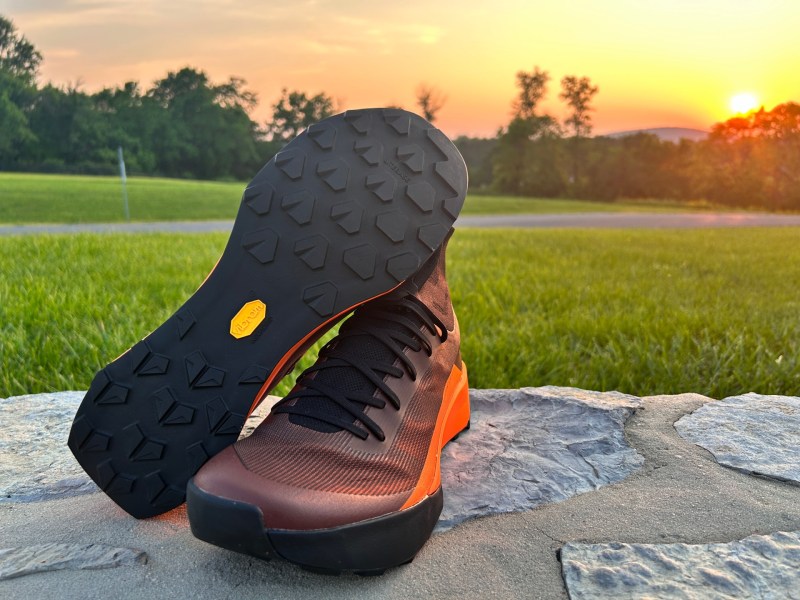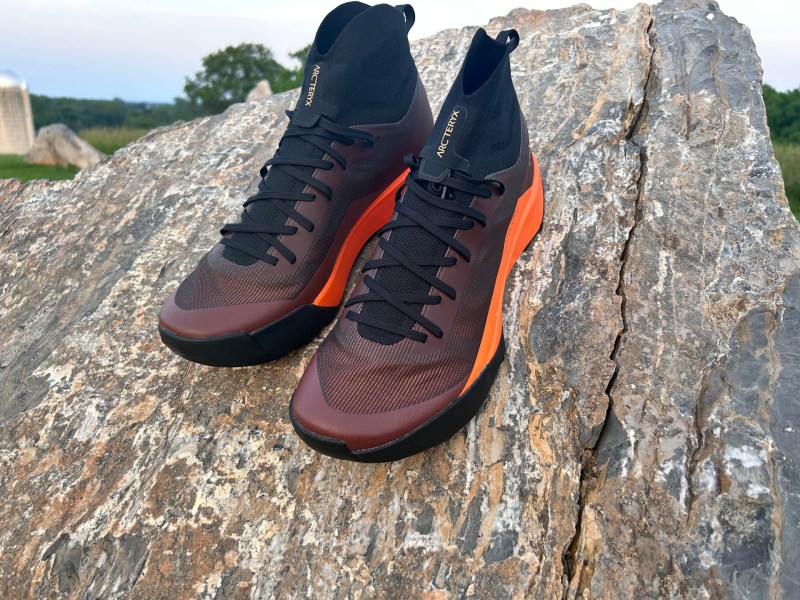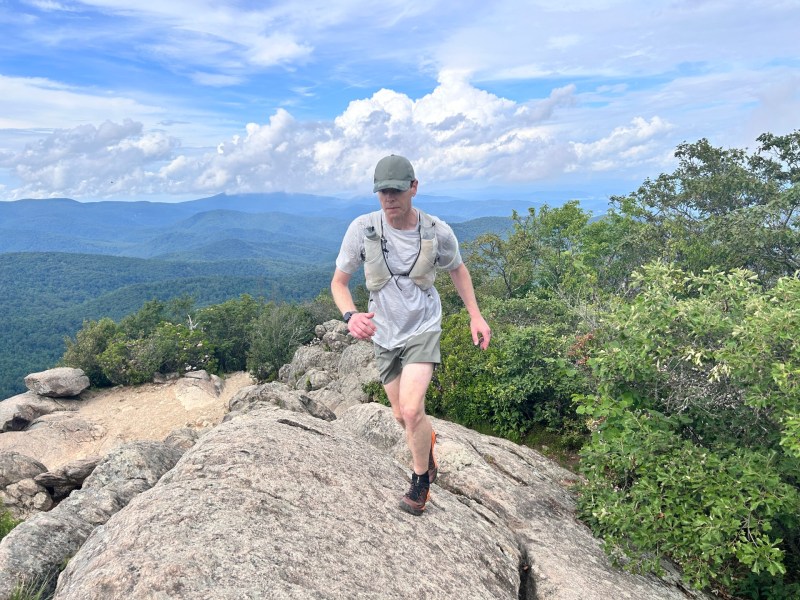Virginia’s Shenandoah National Park is a playground of rocks, roots, boulders, and dirt. There, a trail run can involve hiking, striding, and scrambling over tens of miles and thousands of vertical feet. Bear and snake sightings keep things interesting. It’s truly a place for mountain running.
With these attributes, the park was the perfect place to test Arc’teryx’s latest mountain running shoe, the Vertex Speed. It’s a shoe that blurs the lines between running and climbing, with features catering to each activity. But does the formula work? Here’s my take.
What to know about the Arc’teryx Vertex Speed

The Vertex Speed blends the qualities of mountain running and climbing shoes for an extra edge when encountering boulders and high alpine terrain. While it boasts the svelte silhouette of a trail runner, with a lugged outsole, cushioned midsole, and rugged upper, several details make it stand out among the competition. Ovi Garcia, VP of Footwear for Arc’teryx, described the company’s latest work: “Our expanded product line delivers a unique sharp point on performance in mountain terrain, true to our brand ethos and our athletes. The work our team has done on the product front is outstanding, and we feel confident in our mission to become the leader in pinnacle mountain footwear.”
First is the Vibram outsole, featuring arrowhead-shaped lugs and a solid piece of rubber at the toes, designed for climbing and smearing on boulders and rock formations. The lacing system, with 10 eyelets per side, spans wide across the foot and reminds me of the Danner Mountain Light hiking boot. Arc’teryx opted for a zoned midsole, featuring firmer cushioning up front for stability and a softer heel for comfortable descents. A stretch gaiter seals out debris.
I also tested two Arc’teryx apparel pieces, the Ionia merino wool shirt and the Norvan 5” shorts. Each had the company’s usual perfect fit and finish, along with innovative materials and construction, as listed below.
Arc’teryx Vertex Speed specs
- Price: $190
- Weight: 8 oz. per shoe
- Stack heights: Heel 23 mm, toe 16 mm (7mm drop)
Ionia Merino Wool Shirt specs
- Price: $90
- Ultra-fine merino wool
- Merino fibers wrapped around nylon core for durability
- Articulated patterning for mobility
Norvan Short 5″ specs
- Price: $90
- Diem polyester is lightweight, durable, and breathable
- Articulated patterning for mobility
Pros and Cons of the Arc’teryx Vertex Speed

Pros
- Quality of materials and construction
- Stable, connected feel
- Lightweight and agile
- Traction
- Style and colors
- Lacing lockdown
Cons
- Firm forefoot cushion
- Gaiter causes chafing
- Heel counter could use more stability
How the Arc’teryx Vertex Speed performed

Stepping into the Vertex Speed involved sliding my foot through the gaiter, which then formed a snug fit around my ankle, much like a compression sock. The intricate lacing system locked my foot in place, and I stowed the knot inside the integrated lace garage. Walking around, the low stack height, firm midsole, and narrow outline gave the shoe a solid, connected-to-the-ground sensation.
I took the shoe on multiple climbs to Mary’s Rock in Shenandoah National Park, a loop comprising about 10 miles and 2,500 vertical feet. The route began with a technical hike over streams, root-covered paths, and boulder-strewn staircases. I appreciated the Vertex Speed’s agile feel, which allowed me to dance over tricky roots or uneven sections, and the Vibram outsole locked into the surface, especially rocks.
As the incline increased, the suction-like fit in the heel counter provided drive into the next stride, and the light weight allowed me to maintain a quick cadence. The more I climbed, it became apparent that the Vertex Speed was a mountain tool, designed for just the terrain I was on.
Whenever rocks or boulders appeared, the shoe was in its element. The sole adhered like sandpaper, which gave me confidence crossing rivers or climbing up a steep outcropping. The low, firm forefoot contributed to a stable feel, aiding balance over jagged, sideways sections.
As I noted in my review of the Arc’teryx Sylan, the company’s shoes have an exotic, sportscar-like appearance and the fit and finish to match. My pair came in a vibrant ginger/verve colorway, the outsole resembling the knobby tires on a motocross bike. Toward the forefoot, the upper had a silky sheen that glistened in the light.
When I finally reached Mary’s Rock, I tried bounding up the final outcropping, and the Vertex Speed shone. On the sharp, undulating rock, each step provided reassuring traction and a stable platform, allowing me to maintain my balance. The firm forefoot’s response helped me pop and flow up the mountain. On the descent, the Vertex Speed liked pushing the pace, with the heel cushion offering adequate protection, and the light weight encouraging quick strides.
While the Vertex Speed demonstrated its mettle, the shoe also displayed a narrow focus. The firm 16 mm of forefoot cushioning detracted from the shoe’s running ability on flat dirt paths, requiring me to adjust my technique by using my knees and ankles to absorb foot strikes. There wasn’t the typical absorption and energy return of most trail running shoes. The 23mm of heel cushion was plenty on descents.
The Vertex Speed offered respectable stability, but it could have been better. The Matryx upper, while durable, was pliable, allowing the shoe to flex around my foot rather than hold it in place. That was especially apparent in the heel counter, which I could squeeze and flex between my thumb and forefinger. For mountain running shoes, I prefer a heel counter with little to no flex, which provides a locked-in sensation.
Lastly, the stretch gaiters had a soft, sweater-like feel over my ankles, but caused chafing on my Achilles tendons. It got better as I ran more in the shoes, but you might consider wearing ¾ length socks or using moisturizer.
Turning to apparel, the Ionia merino wool shirt had a fine knit, with a slight weight over the shoulders. It had a wonderful, soft feel, with Arc’teryx’s usual perfect fit and finish. The shirt excelled in temps up to the upper 70s, but due to the wool’s substantial feel and inherent warmth, I wouldn’t use it above 80 degrees. I think it would also make an excellent base layer for winter sports.
The Norvan 5” shorts’ Diem polyester had a barely there feeling and disappeared as I strode through the mountains. They were cool and breathable, working in combination with the Norvan 5” liner, which I previously reviewed.
What type of runner should buy the Arc’teryx Vertex Speed?

The Vertex Speed is a mountain running shoe. It’s not for cruising around flat dirt paths. It’s a design that’s hungry for vertical feet, rocks, and technical ascents. It also likes going fast, as the pared-down, lightweight build thrives during bursts of speed.
But that narrow focus is what makes the shoe cool. When I wore it in Shenandoah National Park, I knew I had the tool for the job — a nimble, sturdy piece of gear that helped me play mountain goat. Think of the Vertex Speed as the shoe version of the Ferrari 296 Speciale, a track-only rocket ship that excels in the right conditions.
The Vertex Speed isn’t perfect, and it isn’t for everyone, but on the right terrain, for the focused mountain runner, it’s a thrill ride.




